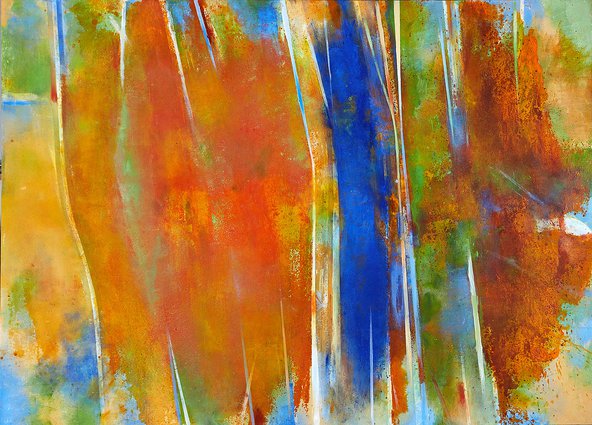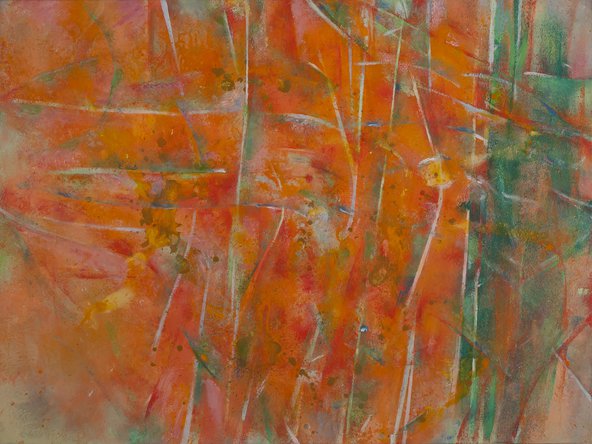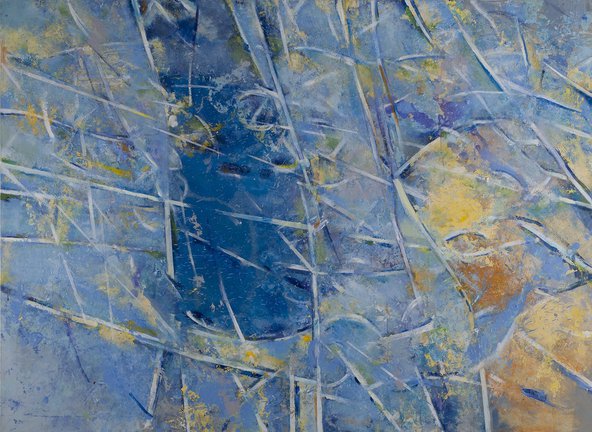Chris Green FBA writes about the artist and art historian John Golding FBA.
It was, I suppose, inevitable that I would want to write about John Golding’s three works on display in the Academy. John was my teacher, then my colleague and my friend. I can boast that I know his writing well enough, but not that I have some special insight into his painting. He rarely took art historians like me into the studio – only a couple of times in my case – and I don’t remember him talking much about his painting, beyond whether it was going well or not. Like anybody else, I start with the paintings and what John has published as an art historian along with the few published statements he made as an artist. First, something about the unusual hybrid John was.
He was elected a fellow of the Academy in 1994. Born in Mexico City, his working life was transatlantic, centred on London, but always in touch with the Americas; and it was a double life. He is the only fellow to have had an international reputation both as a scholar and a painter. Around 1960, publishing his hugely influential study of Cubism, the young Golding was exhibiting with the leading woman Surrealists Leonora Carrington and Remedios Varo in Lima, Peru. His last full-scale paintings were made around 2000 as he delivered and published his A.W. Mellon lectures on 20th Century abstract painting at the National Gallery of Art, Washington, D.C. I think of him as one of a line of British painter-art-writers, among them Walter Sickert, Roger Fry and Lawrence Gowing. He wrote art history as a painter who could put intense visual experiences into words, and, when he turned to abstraction from the mid-1960s, he made paintings that I find so compelling as visual experiences that words can seem irrelevant.

Light from Troy (1986) was painted at the height of his public success as an artist; when he was exhibiting in the Rowan Gallery, then probably the leading London venue for abstract painting and sculpture. Pulse (1991-2) and Arco Iris (1992) were painted as that moment passed, but with his creative energies undiminished. Difficult it may be to find words for them, but John the writer helps.
These paintings fix attention on the surface – the surface expanses of Light from Troy especially are sometimes gritty, sometimes swept smooth. Yet, these are paintings filled with light and space. This contradiction is worth dwelling on. Golding offers a way in when he writes about space, provoked by Frank Stella, the very year he painted Light from Troy: 'I believe there is an alternative to the baroque, swinging, muscular space that Stella proposes, a space that works on us more slowly but which can be just as all-enveloping. This is the space created by light – light that binds and separates objects, planes and shapes, that illuminates and spreads, and that can act upon our perceptions and our senses as powerfully if not physically as the visceral space in which Stella delights'. He liked to talk about folding space, and tensed white bands act like pleats to fold into the tactile surface of Light from Troy depths warmed by burnt oranges and cooled by blues. These bands, now torn in pieces, set the entire surface of Pulse and Arco Iris in stormy motion. I would go along with the many to have found in such Goldings fire, water and air, and I can understand why they are treated by some as surrogate landscapes. John himself didn’t mind such associations, and it is a fact that he only chose horizontal landscape formats between the 1970s and 2000.

Yet, not only did Golding feel compelled to speak about space lit by colour when asked about his work, he also repeatedly insisted that he experienced his paintings as bodies – bodies brought up close, to be touched as well as opened up by vision. Light and space came together, for him, in his canvases, but a couple of years before working on Pulse and Arco Iris, he says of his paintings, light 'falls on the body and explores the surface'. The picture surface is for him like a skin that can be felt as intimately as another’s skin is felt. If you look closely at these three canvases, you see how one reason why they invite touch so insistently is that they have been built over time. Layer after layer of acrylic paint has been laid on more and less roughly. Another effect of this is that underlying colours seep into and flare around surface colours, as if light is being emitted from beneath – as if there is a mysterious, luminous interior beneath the roughened 'skin'. The very way Golding painted Light from Troy, Pulse and Arco Iris meant that, for him as he worked, surface and space were inseparable, the one opened up as the other.

I do not doubt that he felt at a deep level that he was somehow exploring his remembered experience of bodies in making these paintings, but I have to confess that I do not respond to them as bodies. I think that John himself realised that they are too visually eventful, too open to be tied down to one set of associations. Bodies were his way, as he put it, 'up and in' to all his abstract painting, but they do not need to be anyone else’s.